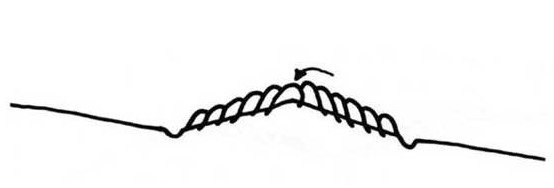By DeAnn Presley
In a dry fall, this window of time between harvest and when the snow flies can be a good time to evaluate and perform maintenance on terraces. In Kansas, over 9 million acres of land is protected by more than 290,000 miles of terraces, making Kansas #2 in the U.S. for this soil and water conservation practice. To accomplish the goal of erosion control and water savings, terraces must have adequate capacity, ridge height, and channel width.
Without adequate capacity to carry water, terraces will be overtopped by runoff in a heavy storm. Overtopping causes erosion of the terrace ridge, terrace back slope, and lower terraces and may result in severe gullies. Terraces are typically designed to handle runoff from a 1-in-10-year storm. The rainfall amounts for such a storm are approximately five inches for eastern Kansas, four inches for central, and three inches for western Kansas during a 24-hour period.
Terraces need regular maintenance to function for a long life. Erosion by water, wind, and tillage wears the ridge down and deposits sediment in the channel, decreasing the effective ridge height, and channel capacity. The amount of capacity loss depends on the type and number of tillage operations, topography, soil properties, crop residue, and precipitation. Terrace maintenance restores capacity by removing sediment from the channel and rebuilding ridge height.
Typically, more frequent maintenance is required for steep slopes and/or highly erodible soils. Annual maintenance is necessary for intense tillage operations and heavy rainfall runoff. Less frequent maintenance is often adequate with high residue levels or where lower rainfall occurs and runoff intensity is low.
Check for needed repairs
Terraces degrade naturally by erosion and sediment, and can be damaged by machinery, animals, settling, and erosion. Check terraces and terrace outlets regularly (at least annually) for needed repairs. The best time to check is after rains, when erosion, sedimentation, and unevenness in elevation are easiest to spot. Specific items to note are overtopping, low or narrow terrace ridges, water ponding in the channel, terrace outlets, erosion, and sediment clogging near waterway or pipe outlets.
Reshaping the terrace
Terrace maintenance can be done with virtually any equipment that efficiently moves soil. Common tools include those that turn soil laterally, such as a moldboard plow, disk plow, one-way, terracing blade (pull-type grader), or 3-point ridging disk (terracing disk, etc.); those that convey or throw soil (belt terracer, scraper, whirlwind terracer, etc.); and those that push or drag soil (dozer blade, straight-wheeled blade, 3-point blade, etc.).
This article discusses procedures for the common plow. For other equipment, get advice from manufacturers, other users (contractor), or experiment to find what works best.
The primary objective in reshaping the terrace is to move soil from the channel to the ridge. Work done on the terrace back slope or cut slope above the channel may help maintain or improve shape but does little to add significant ridge height or channel capacity. Because of improved efficiency, a two-way (rollover) plow is ideal for terrace maintenance. It can usually achieve the desired shape with fewer passes than the conventional plow. Turn the soil in one direction to counteract erosion or turn it in either direction to clear the channel or raise and widen the terrace ridge.
The number of passes required for maintenance depends on the size of the tool, the depth of operation, travel speed (which controls distance of throw), and the amount of soil moved. The plow throws soil further at higher speeds, so a minimum ground speed of 5 mph in loose soil is suggested, but 6 mph or more is better.
Maintenance controls terrace shape. Assess what needs to be done before beginning maintenance. Compare the existing cross-section shape with the desired shape and size, and determine where soil should be removed and where it should be placed for the desired result. Back furrows are placed where more soil is needed, while dead furrows are located where soil needs to be removed. In this way, passes or sets of passes with the equipment are located to achieve the desired results.
Terrace dimensions can be changed by carefully planned placement of back furrows and dead furrows. Large changes in dimension and shape require several sets of passes with the tools or earthmoving equipment. Plan the terrace cross-section shape and size and terrace slope segment length to fit current and future tillage, planting, and harvesting equipment size.
The number of rounds or passes with maintenance equipment depends on the beginning shape of the terrace, size of equipment, and the desired size and shape. If in doubt, make more passes rather than stop too soon. Remember, the loose soil will settle a lot.
Plowing the ridge. The terrace ridge is raised and widened by plowing up from both sides as shown in Figure 1. When a 2-way plow is used, plow just the front slope from the channel to the ridge. Plowing the backslope makes it steeper.

Figure 1. Double back furrow. Arrow indicates the back furrows meeting on the top of the ridge.